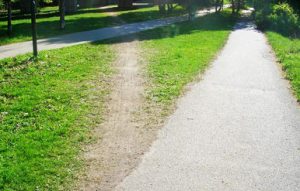Last post I talked about how muscle memory helped me recall my ceramics and track skills even after not practicing either of them for more than a year. But I didn’t really talk about the mechanics of muscle memory – so I figured I better explain it. Here it goes:
You’ve heard of nerves, right?
Think of your nervous system as a series of pathways that allow signals to be carried to each of your muscle groups.
These neural paths run from your brain to your spinal cord and from there into every part of your body. In areas that get a lot of use, your body constructs an infrastructure that will allow tons of signals to pass through. Like in a city, the major highways handle most of traffic. The exits of the highway funnel into various sections of the town, smaller roads lead to side streets, driveways and sidewalks.
The paths branch off into smaller and smaller sections until they reach more and more obscure destinations. Each time you build a new skill, you construct another “road” that leads to a specific group of muscle fibers.
The more frequently you perform the actions, the more firmly established these walkways become.
Our bodies are smart and they begin to adapt to patterns of movement. If certain motions are repeated frequently, small “shortcuts” are formed that allow for the involved muscles to be fired more efficiently. This collection of short-cuts is what muscle memories are made of.
Just like a short-cut path in real life, muscle memories fade if we don’t use them – but traces of the movement patterns remain and they are fairly easy to revive again once we put them back into action.
Usually we think of muscle memories as a good thing, because they help us perform specialized tasks with ease after we practice for a while. But, as I mentioned before, there can be some negative consequences to muscle memory.
For instance, say you are someone who has a Pathological Movement Pattern. “Oh no!” you say, “Not a pathological movement pattern, say it ain’t so!” Yes. It’s so.
A pathological movement pattern is a series of actions that you perform regularly, but you don’t do it properly – so you are actually causing some sort of harm to yourself. A good example of this is someone who has always pronated severely while walking. The pronated foot position has changed the movement of the entire leg and by extension, the rest of the body. Because this motion has been performed for so long, the muscles are used to moving that way; they have established very deeply engrained pathways to support that movement. This means that they are going to be very hard to fix.
It takes a lot of time and effort to erase muscle memories, and the longer you allow yourself to move incorrectly, the harder it will be. This is why exercise is serious business. Every movement you make is a part of your permanent record. If you get into the routine of doing things incorrectly, you will begin to build bad habits and soon you will develop muscular imbalances. Muscular imbalances lead to overuse injuries.
Take this as a warning. Don’t let yourself get stuck in a rut (get, it – like a worn path…)
Exercise correctly (both stretching and strengthening), practice good posture, and wear supportive shoes. Body alignment matters. You don’t want to have to erase bad muscle memories.
Next time, we will talk about the concept of training/ retraining muscle groups to harness the power of muscle memory for good.
Walk well.
Pictures from:
http://upload.wikimedia.org/wikipedia/commons/b/ba/Nervous_system_diagram.png
http://www.johnlund.com/images/JL-interchange__2FG.jpg
http://blog.lenovo.com/images/legacy/files/2011/02/path-shortcut.jpg








Reblogged this on We Are 2Fit2 Quit and commented:
Whats your Muscle IQ?